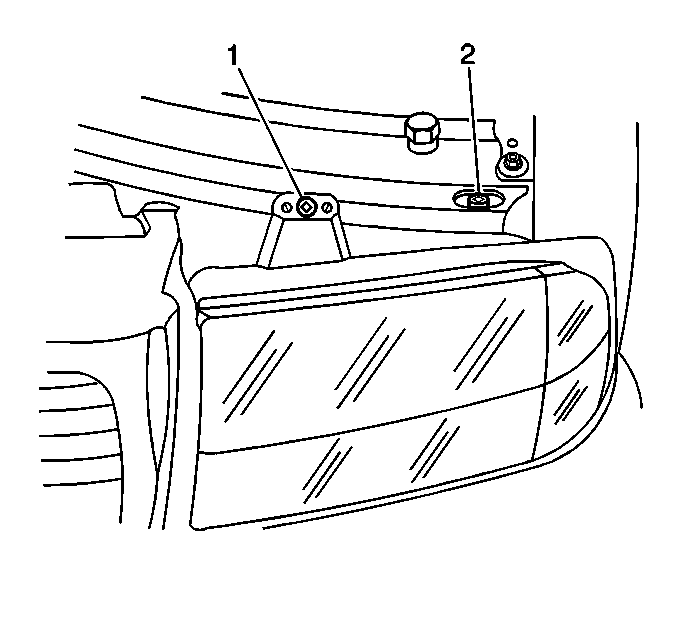
Two adjusting screws control
the horizontal (2) and vertical (1) aiming of each headlamp
assembly.
The hole in the radiator support for each headlamp assembly provides
access to the recessed adjusting screw (2). Using a T15 TORX®
head bit, turn the screws.
Adjust the headlamps to the specifications required by the state and/or
the local authorities.
Headlamp Aiming Using the Screen Method
Location
The area should be darkened and large enough for the vehicle and an
additional 7.62 m (25 ft) measured from the face of the headlamps
to the front of the screen. The floor on which the vehicle rests
must be parallel with the bottom of the screen. Compensate for an uneven
floor, if necessary.
Aiming Screen

If in use, the screen
should be at least 1.52 m (5 ft) in height by 3.66 m
(12 ft) in width. The finish should be matte white. Keep the
surface well shaded from extraneous light. Keep the screen in proper
adjustment with the floor. The screen should be moveable in order
to keep the screen in alignment parallel with the rear axle of
the vehicle. Position the screen so that a horizontal line (3)
drawn perpendicular to the centerline of the screen passes an equal
distance midway between the headlamps.
Provide the screen with the following items:
| • | A vertical centerline (4) |
| • | Two laterally adjustable vertical tapes (2) |
| • | One vertically adjustable horizontal tape (3) |
If a regular, commercial aiming screen is not available, the screen
may consist of a wall having a clear, uninterrupted area of at least 1.52 m
(5 ft) height by 3.66 m (12 ft) width. The
surface should be finished with a washable, no-gloss white paint.
After establishing the aiming screen, paint or tape a reference
line (6) on the floor 7.62 m (25 ft) from
the screen. Park the vehicle with the front of the headlamps directly
over this reference line.
Headlamp Aiming Procedure

- Park the vehicle square with the screen (1).
Park the vehicle with the headlamps directly over the reference line (6).
- Ensure that all of the components are in place, if work has been
completed on the vehicle.
- Ensure that the vehicle is on a level surface.
- Stop all of the other work on the vehicle.
- Ensure that the vehicle has 1/2 tank of fuel or less.
- Close the vehicle doors.
- Rock the vehicle sideways.
- Align the centerline of the vehicle with the centerline (4)
of the aiming screen by completing the following steps:
| 8.1. | Mark the vertical center of the rear and front windows with tape. |
| 8.2. | Use these lines as sight lines in order to match the centerline
of the vehicle with the screen. |
- Adjust the vertical tapes (2) on the screen in order to
match the vertical centerline of each low beam lamp.
- Measure the distance from the centerline of the vehicle to the
centerline of a low beam lamp.
- Adjust the horizontal tapes (3) on the screen in order
to match the horizontal centerline of each low beam lamp.
- Measure the height (5) from the floor to the center of
a low beam.
- Illuminate the low beam lamps.
- Observe the left and top edges of the high intensity zone on the
screen.
- Adjust the headlamps in order to accomplish the following results:
| • | The top edge of each high intensity zone must be within 50.8 mm
(2 in) above to 63.5 mm (2.5 in) below the horizontal
centerlines. |
| • | The left edge of each high intensity zone must be within 101.6 mm
(4 in) to the left or to the right of the vertical centerlines. |
Headlamp Aiming Alternative Procedure
Tools Required
J 25300-A Headlamp
Aimer
- Prepare the vehicle.
- Ensure that all of the components are in place, if other work
has been completed on the vehicle.
- Park the vehicle on a level surface.
- Stop all of the other work on the vehicle.
- Ensure that the vehicle has 1/2 tank of fuel or less.
- Close the doors.
- Rock the vehicle sideways.
- Verify that the headlamps are not illuminated.
- Using the J 25300-A
, adjust the headlamps to the specifications required by the state
and/or local authorities.
| • | Follow the instructions accompanying the tool for the use of the
tool. |
| • | The kit contains special adapters for use with the composite lenses. |
| • | Adjustment settings for the adapter rods can be found on each
headlamp lens face. |



